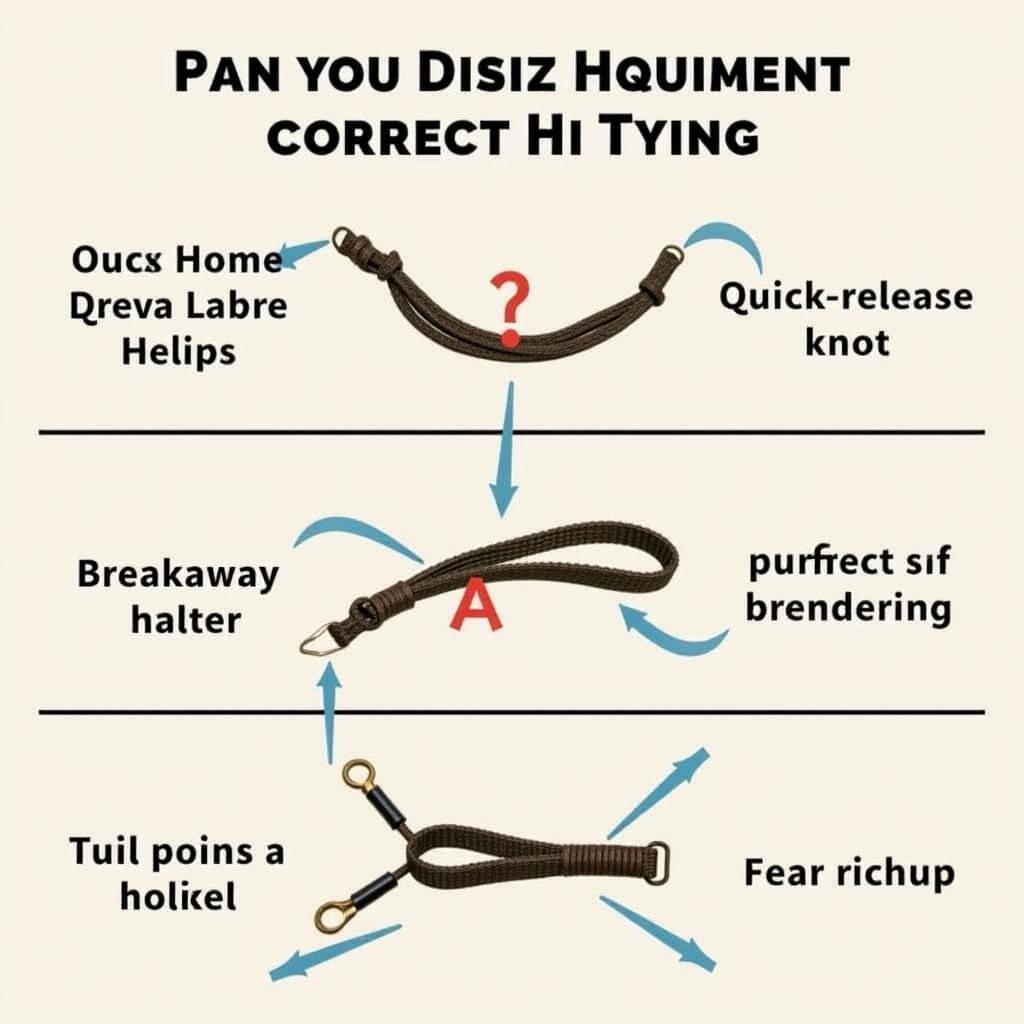The Hi Tie Horse, a practice often debated within the equestrian community, is a method of securing a horse using a high-tied rope. This article delves into the nuances of hi tying, exploring its purpose, potential benefits and drawbacks, and most importantly, how to prioritize horse safety and well-being when utilizing this technique. We’ll also examine alternative methods and the importance of responsible horse ownership.
What is Hi Tying a Horse?
Hi tying involves attaching a rope to a horse’s halter and securing it to a high point, typically above the horse’s head. This practice aims to restrict the horse’s head movement, theoretically encouraging calmness and discouraging pulling back. However, it’s crucial to acknowledge the potential risks associated with hi tying if not executed correctly. It’s essential to understand the proper techniques and safety precautions before attempting to hi tie a horse. Improper use can lead to serious injuries, including damage to the horse’s neck and poll.
The Potential Benefits and Drawbacks of Hi Tying
Some proponents of hi tying argue it can be beneficial in specific training scenarios, such as teaching a horse to stand patiently for grooming or veterinary procedures. They believe that by limiting head movement, the horse learns to relax and accept handling. However, tie down for horses can also be considered for certain training needs.
Conversely, many experienced horse people strongly advise against hi tying, citing the potential for injury and psychological distress. If a horse panics and pulls back against the high tie, it risks serious neck and poll injuries. Furthermore, hi tying can create learned helplessness and fear, potentially damaging the horse’s trust in humans.
Safe Hi Tying Practices (If Absolutely Necessary)
If, after careful consideration and consultation with a qualified equine professional, you determine that hi tying is necessary, adhere to these safety guidelines:
- Use a quick-release knot: This allows for immediate release in case of emergency.
- Never tie to a fixed object: The tie point should have some give, such as a properly secured rope attached to a high, strong beam.
- Use a breakaway halter: This will break under pressure, minimizing the risk of injury if the horse panics.
- Supervise the horse constantly: Never leave a hi-tied horse unattended.
 Safe Hi Tie Setup
Safe Hi Tie Setup
Alternatives to Hi Tying
Fortunately, several safer and more humane alternatives to hi tying exist. These include:
- Ground tying: Teaching a horse to stand patiently on the ground without being tied.
- Low tying: Tying the horse at chest height to a sturdy, safe tie ring.
- Cross-tying: Securing the horse with two ropes attached to opposite sides of the stall or trailer. You might even consider using a best homemade horse fly spray to keep the horse calm during these procedures.
- Patience and positive reinforcement: Building trust and encouraging desired behaviors through consistent training.
Why is My Horse Pulling Back When Tied?
Understanding why a horse pulls back is crucial to addressing the issue safely and effectively. Common reasons include fear, improper training, and discomfort. Consult with a professional trainer to identify the root cause and develop a suitable training plan.
What Height Should a Hi Tie Be?
If hi tying is deemed absolutely necessary by a professional, the tie point should be slightly above the horse’s withers, allowing for natural head carriage. However, it’s crucial to reiterate the risks associated with this method and explore safer alternatives.
Is Hi Tying Cruel?
Many experts consider hi tying to be inherently risky and potentially cruel. The potential for injury and the psychological stress it can cause make it a practice best avoided.
Expert Insights on Hi Tying
Dr. Emily Carter, DVM, Equine Specialist, emphasizes, “Hi tying carries significant risks, and safer, more humane alternatives are almost always available. Prioritize your horse’s well-being by choosing training methods that build trust and minimize the potential for harm.” Similarly, renowned horse trainer, John Miller, adds, “Patience and positive reinforcement are far more effective than restrictive methods like hi tying. Invest the time in building a strong relationship with your horse, and you’ll be rewarded with a willing and cooperative partner.”
Conclusion
While the hi tie horse method may seem like a quick fix, it carries inherent risks that should not be overlooked. Prioritizing the horse’s safety, both physically and mentally, is paramount. Exploring safer alternatives, like ground tying or low tying, and focusing on positive reinforcement training methods will foster a stronger bond and a more positive training experience for both horse and owner. Remember, responsible horse ownership involves making informed decisions that prioritize the horse’s well-being above all else. For additional information, you might find resources on clandestine horse helpful. Avoid practices like those depicted in gay horse zoophilia porn as they are harmful and unethical.
FAQ
- What are the dangers of hi tying a horse?
- What are some alternatives to hi tying a horse?
- How can I train my horse to stand tied safely?
- What type of halter should I use for tying a horse?
- When should I consult a professional trainer for tying issues?
When you need support, please contact us via Phone: 0772127271, Email: [email protected] or visit our address: QGM2+WX2, Vị Trung, Vị Thuỷ, Hậu Giang, Việt Nam. We have a 24/7 customer service team.